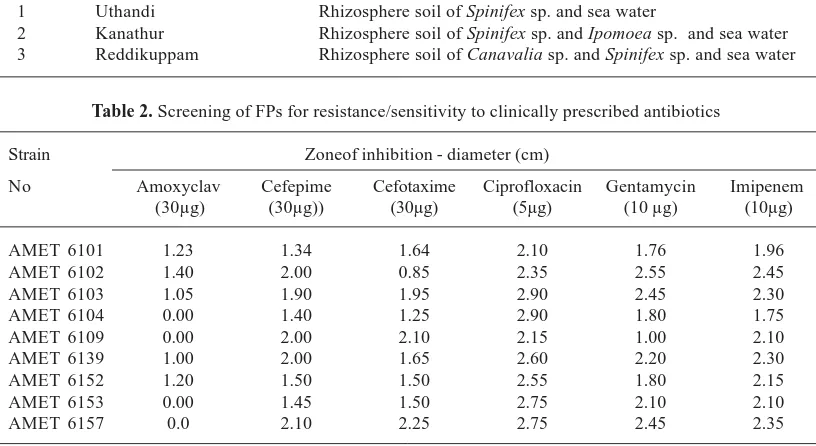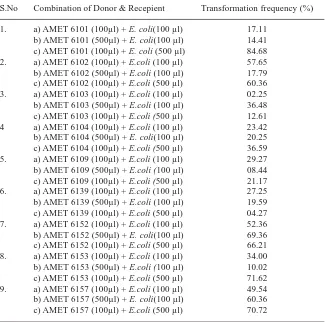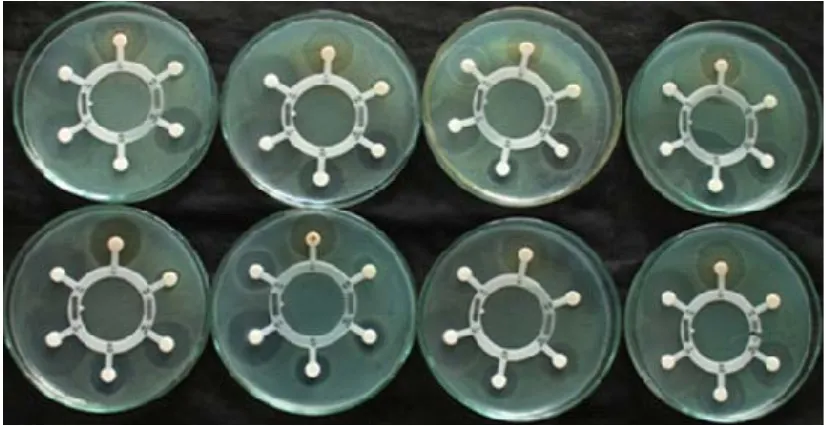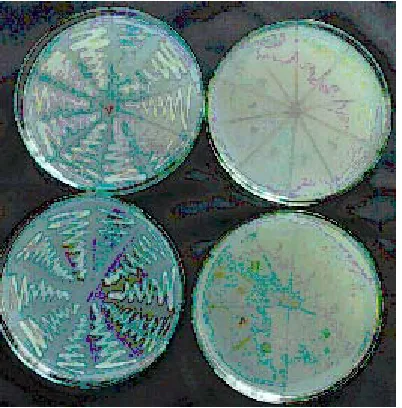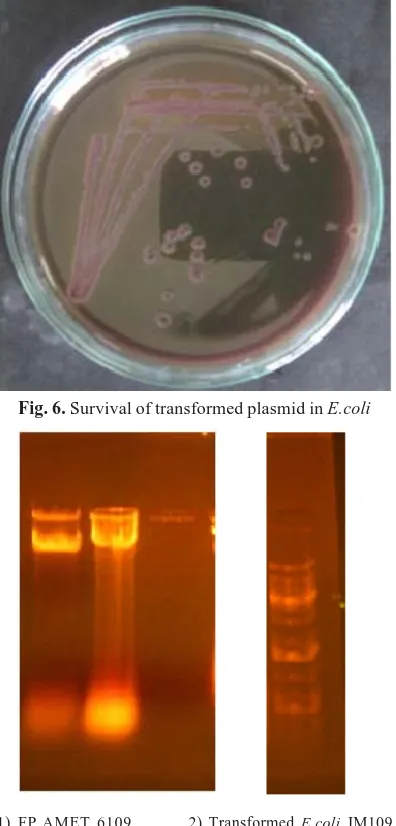* To whom all correspondence should be addressed. Mob.: +91-9566503862;
E-mail: vanithab@ametuniv.nic.in
Horizontal Transfer of Chloramphenicol Resistance
Plasmids from Marine associated Pseudomonas spp. to
Escherichia coli JM109
M. Jayaprakashvel1, S. Achuthan, B. Prakash2, M.C. Vanitha3* and A. Jaffar Hussain3
1Department of Marine Biotechnology, AMET University, Kanathur, Chennai - 603112, India. 2Departmentof Biotechnology, PGP Arts and Science, Namakkal - 637207, India. 3Centre for Marine Bioprospecting, AMET University, Kanathur, Chennai - 603112, India.
doi: http://dx.doi.org/10.13005/bbra/1385
(Received: 15 August 2014; accepted: 10 October 2014)
The present study has concentrated on the antibiotic resistance pattern and transferability of the plasmid mediated resistance of marine bacteria. A total of 9 different samples comprising of rhizosphere of coastal sand dune plants and sea water were used in the study to isolate fluorescent pseudomonads (FPs). From these samples pseudomonas were isolated by spread plate technique using Kings B agar about 60 FPs were isolated and were screened primarily for pigment production in KB agar. When screened for antibiotic resistance the isolates AMET6109 and AMET6152 have exhibited average growth in the presence of high concentration of chloramphenicol .For plasmid transfer experiments a total of nine donor strains (Pseudomonas sp) were tested for three different donor recipient (Escherichia coli JM109) ratio. The co cultured bacteria were spread plated on EMB agar amended with Chloramphenicol (100 μg/mL concentration). To demonstrate the transformed chloramphenicol resistant plasmid from E.coli, the transformed E.coli was streaked on antibiotic amended EMB agar plate. The ability of transformed bacterium in subsequent generations in the antibiotic amended medium denotes the survival of the transferred plasmid.
Key words: Antibiotic resistance, Pseudomonas spp., curing,Escherichia coli JM109.
The use of antibiotics in clinical therapy of human infectious diseases during past 50 yrs has resulted in rapid global spread of antibiotic determinants. Residues from human environments and from farms may contain antibiotics and antibiotic resistance genes that can contaminate natural environments 1. During the past few years, research has revealed not only how such resistance mechanisms have been able to evolve and to rapidly disseminate, but also how bacteria have, in some
organism such as E.coli 3. These antibiotic determinants are usually located on mobile genetic elements such as conjugative plasmids 4 or conjugative transposons 5 which ensure their dissemination among bacterial populations via horizontal gene transfer. Horizontal gene transfer is defined to be the movement of genetic material between bacteria other than by descent in which information travels through the generations as the cell divides 6. Gene transfer studies carried out under more natural conditions such as in model ecosystems or in the environment established that all gene transfer mechanisms worked under these conditions.7 Moreover, environmental hot-spots were identified where favourable conditions such as nutrient enrichment increased the probability of genetic exchange among bacteria. Understanding the epidemiology of antibacterial resistance will enable us to develop preventive strategies to limit existing resistance and to avoid the emergence of new strains of resistant bacteria 8. The significance of this finding is that, gram
negative bacteria harbor different plasmids which give them multiple antibiotic resistances to many unrelated antibiotics and give the ability to survive in the environment especially in the soil, water etc. Since, the coliforms and Pseudomonas are dominant bacteria in the soil and water, horizontal transfer of antibiotic resistance genes through conjugative plasmids do often occur among them and therefore, make these important bacteria multiple resistant to several antibiotics .One strategy to minimize plasmid transmission of antibiotic resistance is to eliminate the plasmids. This process is known as ‘curing’ and many compounds have been shown to be capable of causing this effect 9. In this context, the present study has concentrated on the antibiotic resistance pattern and transferability of the plasmid mediated resistance of marine bacteria. The transfer of antibiotic (chloramphenicol) resistance plasmids were transferred from few marine bacteria to E. coli JM109 a model organism
MATERIALS AND METHODS
Cultures and culture conditions
All the bacterial strains used in this study were maintained in nutrient agar slants at 4°C.
Escherichia coli JM109 strain that harbors no
plasmids was obtained from Biocontrol and
Microbial Metabolies Lab, CAS in Botany, University of Madras, Chennai .
Collection of seawater and rhizosphere samples
Sea water and rhizosphere soil samples were collected from beaches of Uthandi, Reddikuppam and Kanathur along the Bay of Bengal in Chennai coastline (Table 1).
The soil and sea water samples were serially diluted in sterile distilled water up to 10-6 dilution and the dilutions 10-4 and 10-6 were spread plated on Kings B Agar Medium prepared in distilled water. The plates were kept for incubation at room temperature for 48 hrs. After 48 hrs, the plates were observed for fluorescent colonies under the UV illumination in a transilluminator. The distinct colonies that show blue/blue green fluorescence were identified as fluorescent pseudomonades and subcultured to purity on Kings B Agar medium. All the strains were stored in nutrient agar slants at 4°C. All the cultures were given a unique accession number with a prefix AMET.
Biochemical characterization to identify the selected strains
Selected 9 fluorescent pseudomonads were further subjected to various staining and biochemical tests to confirm their generic identity. The tests such as gram staining, simple staining, motility, IMViC test, oxidase and catalase tests, Oxidation fermentation test, gelatin liquefaction, starch hydrolysis, growth at 4 and 41°C using standard procedures.
The various physiological and biochemical tests were carried out according to the methods outlined in the Bergey’s Manual of Determinative Bacteriology for the identification of selected 9 strains
Antibiotic resistance/sensitivity
average growth and +++ indicates good growth in comparison with antibiotic free control plate were all the growth were recorded as +++.
Six commercial antibiotics such as Amoxyclav (30µg), cefepime (30µg), cefotaxime (30µg), ciprofloxacin (5 µg), gentamycin (10 µg) and imepenem (10 µg ) that were used to clinical infections caused by gram negative bacterial pathogens. These antibiotics were tested as a OCTADISC provided by Himedia Mumbai. Bacterial strains were swabbed allowed to aid dry in Laminar air flow chamber and on top of it the bacterial discs were placed. The NA plates without antibiotics served as controls. The plates were incubated at room temperature for 24 h and observed for the presence or absence of a lytic zone around antibiotic discs.
Isolation of plasmid
All the selected 9 Pseudmonas spp. were grown in nutrient broth for 24 h and subjected to the alkaline lysis plasmid isolation procedure as described by 10.
Curing of plasmids
All the 9 Pseudomonas spp. containing plasmids were subjected to plasmid curing experiment. Acridine Orange (400 mg/ml for 2 h) was used as curing agent. The cell pellet, alone which was obtained by centrifugation at 8000 rpm, was treated for 2 h with Acridine Orange after which it was serially diluted and spread plated on NA plates.
Demonstration of plasmid mediated antibiotic resistance
After 24 h the colonies appeared on NA plates were replica plated on Chloramphenicol (100 mg/ml) amended NA plates. The colonies which failed to grow in tetracycline amended plates were assumed that they lost their plasmid in the curing process and hence the tetracycline resistance harbored by them is plasmid mediated. However, both Acridine Orange treated and untreated bacteria were used for the isolation of plasmids and the loss of plasmids/ retaining of plasmids were confirmed through agarose gel electrophoresis study.
Plasmid transfer experiments Recipient strain
Escherichia coli JM109, a plasmid less
strain which is susceptible to Chloramphenicol even at 25 mg/ml concentration was obtained from
Biocontrol and Microbial Metabolites laboratory, CAS in Botany, University of Madras. The strain was already used in several molecular biology experiments as a model strain.
Growth of donor and recepient bacterium
Both the donor Pseudomoas spp. (9 strains) and recipient Escherichia coli JM109 were grown in NB at room temperature for 12 h.
Transfer of plasmid
Three combinations of donor and recipient were fixed to find the effective dose of donor and recipient for optimal plasmid transfer. The combinations are as follows
1. Donor 100 µL and recipient 100 µL 2. Donor 500 µL and recipient 100 µL 3. Donor 100 µL and recipient 500 µL
In all the combinations respective volume of bacterial suspensions were taken in a sterile eppendorf tube and mixed well. Then this donor recipient mixture was inoculated in nutrient broth. The mixtures were kept in room temperature for 12 h. Then, the donor recipient mixture from each treatment was serially diluted up to 10-6 and plated on EMB agar (HiMedia, Mumbai) supplemented with Chloramphenicol (100 mg/ml).
The number of metallic sheen E. coli
colonies that were observed in Chloramphenicol amended EMB agar plates is expressed as the number of transformed E. coli cells.
Demonstration of transformed chloramphenicol resistant plasmid from E.coli
Transformed single E. coli JM109 colonies were selected from antibiotic amended EMB agar plate was inoculated in NB and incubated in shaken condition for 24 h. After the incubation, plasmid DNA was isolated from the culture by the above said procedure.
Survival of plasmid in E. coli
The transformed E. coli was streaked on antibiotic amended EMB agar plate and from that 24 h old same culture was used for subsequent inoculations in the same medium for five generations. The ability of transformed bacterium in subsequent generations in the antibiotic amended medium denotes the survival of the transferred plasmid.
RESULTS AND DISCUSSION
sea water were used in the study to isolate fluorescent pseudomonads. The samples were inoculated on KBA after serial dilution and were observed for fluorescent colonies under UV illumination after two days of incubation . Surprisingly sea water contains more number of FP colonies than the rhizosphere. This observation was in agreement with the previous report that the pseudomonads population is determined by environmental conditions such as soil type and pH and not essentially the rhizosphere of plants 11. The establishment of an introduced community of The fluorescent pseudomonads in the soil and in
the rhizosphere is affected by the soil type .12 have also reported similarly that. Distinct fluorescent colonies were isolated and sub-cultured to purity on KBA . A total of sixty FPs were isolated in pure culture. The colony morphology of all the 60 FPs were also recorded. The colonies exhibited mixed pattern of circular and irregular colonies.
As suggested by Pierson and Pierson13, the metabolites including the fluorescent pigments of pseudomonas are subject to be affected by various environmental, nutritional and physiological factors. So, all the 60 FPs were tested for their consistency in pigment production in
Table 1. Isolation of fluorescent pseudomonades from the marine samples
S. No. Sampling Location Samples
1 Uthandi Rhizosphere soil of Spinifex sp. and sea water
2 Kanathur Rhizosphere soil of Spinifex sp. and Ipomoea sp. and sea water 3 Reddikuppam Rhizosphere soil of Canavalia sp. and Spinifex sp. and sea water
Table 2. Screening of FPs for resistance/sensitivity to clinically prescribed antibiotics
Strain Zoneof inhibition - diameter (cm)
No Amoxyclav Cefepime Cefotaxime Ciprofloxacin Gentamycin Imipenem (30µg) (30µg)) (30µg) (5µg) (10 µg) (10µg)
AMET 6101 1.23 1.34 1.64 2.10 1.76 1.96 AMET 6102 1.40 2.00 0.85 2.35 2.55 2.45 AMET 6103 1.05 1.90 1.95 2.90 2.45 2.30 AMET 6104 0.00 1.40 1.25 2.90 1.80 1.75 AMET 6109 0.00 2.00 2.10 2.15 1.00 2.10 AMET 6139 1.00 2.00 1.65 2.60 2.20 2.30 AMET 6152 1.20 1.50 1.50 2.55 1.80 2.15 AMET 6153 0.00 1.45 1.50 2.75 2.10 2.10 AMET 6157 0.0 2.10 2.25 2.75 2.45 2.35
KBA. It has been found that nine strains namely AMET6101, AMET6102, AMET6103, AMET6104, AMET6109, AMET6139, AMET6152, AMET6153 and AMET6157. These strains have exhibited consistent yellow green pigments for about two days in the KBA medium. So, they were selected for further studies.
Selected 9 fluorescent pseudomonades were further subjected to various staining and biochemical tests to confirm their generic identity. Surprisingly all the nine FP isolates have given uniform results to all the test except iodole and VP
tests . However, the most important characteristics such as gram negative, rod shaped, motile, catalase oxidate positive, oxidative and grows well in cetrimide agar has clearly indicated that these strains are Pseudomonas spp (Fig 1). Since these bacteria have produced yellow green pigments they might belong to Pseudomonasfluorescence.
However, species level identification requires molecular taxonomic studies.
Table 3. Frequency of gene plasmid transfer among FPs and E. coli JM101
S.No Combination of Donor & Recepient Transformation frequency (%)
1. a) AMET 6101 (100µl) + E. coli(100 µl) 17.11 b) AMET 6101 (500µl) + E. coli(100 µl) 14.41 c) AMET 6101 (100µl) + E. coli (500 µl) 84.68 2. a) AMET 6102 (100µl) + E.coli (100 µl) 57.65 b) AMET 6102 (500µl) + E.coli (100 µl) 17.79 c) AMET 6102 (100µl) + E.coli (500 µl) 60.36 3. a) AMET 6103 (100µl) + E.coli (100 µl) 02.25 b) AMET 6103 (500µl) + E.coli (100 µl) 36.48 c) AMET 6103 (100µl) + E.coli (500 µl) 12.61 4 a) AMET 6104 (100µl) + E.coli (100 µl) 23.42 b) AMET 6104 (500µl) + E. coli(100 µl) 20.25 c) AMET 6104 (100µl) + E.coli (500 µl) 36.59 5. a) AMET 6109 (100µl) + E.coli (100 µl) 29.27 b) AMET 6109 (500µl) + E.coli (100 µl) 08.44 c) AMET 6109 (100µl) + E.coli (500 µl) 21.17 6. a) AMET 6139 (100µl) + E.coli (100 µl) 27.25 b) AMET 6139 (500µl) + E.coli (100 µl) 19.59 c) AMET 6139 (100µl) + E.coli (500 µl) 04.27 7. a) AMET 6152 (100µl) + E.coli (100 µl) 52.36 b) AMET 6152 (500µl) + E. coli(100 µl) 69.36 c) AMET 6152 (100µl) + E.coli (500 µl) 66.21 8. a) AMET 6153 (100µl) + E.coli (100 µl) 34.00 b) AMET 6153 (500µl) + E.coli (100 µl) 10.02 c) AMET 6153 (100µl) + E.coli (500 µl) 71.62 9. a) AMET 6157 (100µl) + E.coli (100 µl) 49.54 b) AMET 6157 (500µl) + E. coli(100 µl) 60.36 c) AMET 6157 (100µl) + E.coli (500 µl) 70.72
chloramphenicol and tetracycline at 150µg/mL concentration have inhibited few strains completely. Even in this high concentration, the isolates AMET6109 and AMET6152 have exhibited average growth in the presence of chloramphenicol (Figure 2).
Several researchers across the globe have reported the antibiotic resistance of pseudomonades especially Pseudomonas aeruginosa14,-16. In the present study six clinically prescribed antibiotics such as Amoxyclav (30µg), Cefepime (30µg), Cefotaxime (30µg), Ciprofloxacin (5µg), Gentamycin (10 µg) and Imipenem (10µg) have been tested against all the nine fluorescent pseudomonads . These six antibiotics are clinically prescribed for gram negative pathogenic bacterial infections. Here, four FP strains namely AMET6104, AMET 6109, AMET 6153 and AMET 6157 have exhibited remarkable resistance towards Amoxyclav at 30µgconcentration. However, other strains have exhibited susceptibility/resistance to
other antibiotics tested (Table 2).
All the selected 9 Pseudomonas spp. were grown in nutrient broth for 24 h and subjected to the alkaline lysis plasmid isolation procedure. Plasmids were observed in the agarose gels. This has confirmed that all the nine isolates harbor plasmids . Bengtsson et al. 17 have reported the antibiotic resistance plasmid RP4 in Pseudomonas
putida isolated from ground water. Several
multidrug-resistant Pseudomonas aeruginosa
strains isolated from hospitalized burn patients in a tertiary care hospital of North India were found harboring R-plasmids and AmpC ²-lactamase18. Shahcheraghi et al. 19 have reported the serovar determination, drug resistance patterns and plasmid profiles of Pseudomonas aeruginosa
isolated from burn patients at two hospitals of Tehran. The above studies and the present study have clearly indicated that many species of
Pseudomonas harbors antibiotic resistance
Fig. 1. Growth in cetrimide agar
Fig. 2. Screening of selected FPs for Antibiotic resistance
antibiotic resistance strains.
Intercalating dyes such as a acriflavine, acridine orange, ethidium bromide and quinacrine have been successfully used in curing bacteria of plasmids 20. One way to reverse the resistance of emerging or engineered bacteria is to specifically target the plasmids rather than using methods to directly kill the cells. In present study plasmid curing experiments for all the 9 Pseudomonas spp were done using acridine orange. The plasmid cured strains have failed to grow in the antibiotic amended medium. But the wild untreated strains as usual have grown well in antibiotic amended medium (Figure 3). The strain AMET 6157 has exhibited absolute plasmid curing frequency (100%). Three FP strains AMET 6101, AMET 6104 and AMET 6153 have exhibited less than 5% of plasmid curing
frequency (Fig 4). James Wechsler and Bruce C. Kline 21 have used acridine orange for mutation and identification of the F plasmid locus determining resistance. The colonies which failed to grow in Chloramphenicol amended plates were assumed that they lost their plasmid in the curing process and hence the chloramphenicol resistance harbored by them is plasmid mediated. Several workers have demonstrated plasmid mediated antibiotic resistance in many of the microbial systems. Campbell et al.22 have studied extensively
on the occurrence of plasmids in the genus
Pseudomonas isolated from natural environments
such as agricultural soils. In the present study also, the plasmids from Pseudomonas spp. isolated from marine environment are found to harbor antibiotic resistant plasmids.
Fig. 3. Plasmid curing experiment
Fig. 4. Frequency of plasmid curing in selected FPs
Fig. 5. Horizontal transfer of chloramphenicol resistance plasmids from FPs to E.coli JM109
Several workers have demonstrated the plasmid transfer experiments in both laboratory and natural conditions. Satoshi Soda et al. 23 have transferred multi resistant plasmid RP4 from Escherichia coli
to activated sludge bacteria using mating techniques in growth media. Chloramphenicol resistance plasmids have also been transferred previously. The effect of different concentrations of chloramphenicol on the original strain and on the plasmid-cured E. coli strain was studied and found that the plasmid-cured strain displayed lower resistance for chloramphenicol than the wild type.
E. coli is an important commensal or pathogen that
inhabits the gastrointestinal tracts of humans and animals, so a plasmid encoded active drug resistance mechanism can be a potential source of horizontal transfer of resistance 24.
al.26 have examined the survival of a host
Escherichia coli K-12 bacterium containing two
transferable plasmids (pLM2, pSL222-4) and one poorly mobilizable plasmid (pBR322), and the transfer of these three plasmids to endogenous bacteria in the human intestinal tract. The survival of this plasmid-carrying host organism in four human volunteers was 3.5 to 6 days.
In the present study, the transformed E. coli JM109 was streaked on antibiotic amended EMB agar plate and from that 24 h old same culture
Fig. 6. Survival of transformed plasmid in E.coli
Fig. 6a. Transformed E.coli after 5 generations in Chloramphenicol amended EMB agar
1) FP AMET 6109 2) Transformed E.coli JM109 3) E.coli JM109
was used for subsequent inoculations in the same medium for five generations (Fig 6a). Plasmids of both transformed E. coli JM109 and Pseudomonas
spp. were isolated and compared for similarities (Figure 6b). The ability of transformed bacterium in subsequent generations in the antibiotic amended medium has given the evidence for the survival of the transferred plasmid.
CONCLUSION
The marine environment contains antibiotic resistant fluorescent pseudomonas. These FPs are readily transfer their plasmids to other bacteria. This has to be seriously considered as this organism may transfer antibiotic resistance to sea food pathogens and human pathogens in natural environments and may cause severe threat to public health.
REFERENCES
1. LevySB, Antibiotic resistance: consequences of inaction. Clin. Infect. Dis. 2001; 33(3): S124-S129.
2. Morris A, Kellner J D, Low D E, The superbugs: evolution, dissemination and fitness. Curr Opin Microbiol. 1998; 1(5):524-9.
3. Bennett PM, Plasmid encoded antibiotic resistance: acquisition and transfer of antibiotic resistance genes in bacteria.Br J Pharmacol.;
2008; 153(1): S347–S357.
4. Datta N, Hughes VM, Plasmids of the same Inc groups in Enterobacteria before and after the medical use of antibiotics. Nature ; 1983; 306: 616-617.
5. Saylers AA, Shoemaker NB, Broad host range gene transfer: plasmids and conjugative transposons. FEMS Microbiol. 1994; 15: 15-22.
6. Davison J, Genetic exchange between bacteria in the environment. Plasmid; 1999; 42: 73-91. 7. Dröge M, Pühler A, Selbitschka W, Horizontal
gene transfer as a biosafety issue: a natural phenomenon of public concern. J Biotechnol.; 1998; 64(1):75-90.
8. Guillemot D, Antibiotic use in humans and bacterial resistance. Current Opinion in Microbiol. 1999; 2(5): 494-498.
9. Caro L, Churchward G,Chandler M, Study of plasmid replication in vivo methods microbial.
1984; 17: 72-1 22.
for the isolation of plasmid DNA. Nucleic Acids Res. 1983; 7(6): 1513-23.
11. Verma R, Singh NA, Kumar S, Prasad R, Shanmugam V, Influence of soil reaction on diversity and antifungal activity of fluorescent pseudomonads in crop rhizospheres.
Bioresource Technol.; 2007; 98(7): 1346-1352. 12. Latour X, Philippot L, Corberand T, Lemanceau P, The establishment of an introduced community of fluorescent pseudomonads in the soil and in the rhizosphere is affected by the soil type. FEMS Microbiol Ecology; 1999; 30(2): 163-170.
13. Pierson III, LS and Pierson EA, Phenazine antibiotic production in Pseudomonas aureofaciens: role in rhizosphere ecology and pathogen suppression. FEMS Microbiol Letters.; 1996; 136(2): 101-108.
14. Bert F, Lambert-Zechovsky N, Antibiotic resistance patterns in Pseudomonas aeruginosa: an8year surveillance study in a French hospital.
Inter Journal of Antimicr Agents; 1997; 9(2) : 107-112.
15. Estahbanati HK, Kashani PP, Ghanaatpisheh F, Frequency of Pseudomonas aeruginosa
serotypes in burn wound infections and their resistance to antibiotics. Burns; 2002; 28(4): 340-348.
16. Bengtsson G, Fossum A, Lindqvist R, Persistence of plasmid RP4 in Pseudomonas putida and loss of its expression of antibiotic resistance in a groundwater microcosm. Soil Biol Biochem.; 2004; 36(6): 999-1008.
17. Shahid M, Malik A, Sheeba C, Multidrug-resistant Pseudomonas aeruginosa strains harbouring R-plasmids and AmpC β-lactamases isolated from hospitalised burn patients in a tertiary care hospital of North India. FEMS Microbiol Letters; 2003; 228(2): 181-186. 18. ShahcheraghiF, Feizabadi M M, Yamin V, Abiri
R, AbedianZ, determination, drug resistance
patterns and plasmid profiles of Pseudomonas aeruginosa isolated from burn patients at two hospitals of Tehran (IRAN). Burns 2003; 29(6): 547-551.
19. Cansado J, Longo E, Agrelo D, Tomás , Villa G, Curing of the killer character of Saccharomyces cerevisiae with acridine orange. FEMS Microbiol Letters .1989; 65(1-2): 233-237.
20. Wechsler J, Bruce C, Kline. Mutation and identification of the F plasmid locus determining resistance to acridine orange curing. Plasmid;
1980; 4(3): 276-280.
21. Campbell JIA, Carsten S, Jacobsen, Sørensen J, Species variation and plasmid incidence among fluorescent Pseudomonas strains isolated from agricultural and industrial soils. FEMS Microbiology Ecology. 1995; 18(1): 51-62. 22. Soda S, Otsuki H, Inoue D, Tsutsui H, Sei K,
Michihiko I, Transfer of antibiotic multiresistant plasmid RP4 from Escherichia coli to activated sludge bacteria. Journal of Biosci and Bioeng;
2008; 106( 3): 292-296.
23. Moreira MAS, Oliveira JA, Teixeira LM, Moraes CA, Detection of a chloramphenicol efflux system in Escherichia coli isolated from poultry carcass. Veterinary Microbiol; 2005;
109(1-2)10:75-81.
24. Lampkowska J, Feld L, Monaghan A, Toomey N, Susanne S, Bodil J, Hilko van der V, S R Andersen, Bolton D, Henk A, Karen A, Krogfelt, Andrea W, Jacek B, A standardized conjugation protocol to asses antibiotic resistance transfer between lactococcal species. International Journal of Food Microbiol.; 2008; 127( 1-2) : 172-175.
